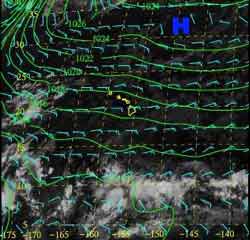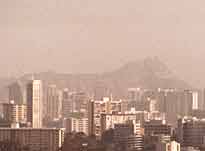THE NATURAL ENVIRONMENT
Geography 101
ToC
WEATHER
Lifting
Air Mass
Fronts
Hurricane
Hawaii
WEATHER PATTERNS dominated by HIGH PRESSURE
 The
Subtropical High Pressure ridges are among the most dependable
features of Earth's weather. While they may move and change strength,
they are
virtually always present, shifting between 20° and 40° latitude
in both hemispheres depending on the season. At the center of the high, air descends toward
the surface producing clear skies, calm winds, and dry, warm conditions. Over land,
these stationary highs cause the world's great deserts, such as the Sahara
and Kalahari. Over the oceans, they drive the vast trade wind belts.
In the northern hemisphere, air circulates clockwise around high pressure
and slightly outward from the center. This motion, and its counterpart
in the southern hemisphere, produces a swath of easterly winds covering
half the planet's surface between about 30° north and 30° south latitude.
The
Subtropical High Pressure ridges are among the most dependable
features of Earth's weather. While they may move and change strength,
they are
virtually always present, shifting between 20° and 40° latitude
in both hemispheres depending on the season. At the center of the high, air descends toward
the surface producing clear skies, calm winds, and dry, warm conditions. Over land,
these stationary highs cause the world's great deserts, such as the Sahara
and Kalahari. Over the oceans, they drive the vast trade wind belts.
In the northern hemisphere, air circulates clockwise around high pressure
and slightly outward from the center. This motion, and its counterpart
in the southern hemisphere, produces a swath of easterly winds covering
half the planet's surface between about 30° north and 30° south latitude.
 Normal
(Dry) Trade Winds: "FORECAST: sunny, mauka showers, trade winds
16-40 kph (10-25 mph), cool nights, highs near 30° C (mid-80's °F), lows near 24° C (mid 70's °F)." In
Hawai'i,
dry trade winds are the most common weather pattern, especially in summer.
A stationary high is generally parked to the north-northeast of
the islands (officially called the East Pacific Ocean Subtropical High-pressure
center, but generally shortened to: the Hawaiian High) producing
the familiar northeast trade winds as shown in the typical wind-field image above. Winds
average between 16 to 40 kph (10-25 mph) and skies are clear with a few puffy
cumulus clouds. Showers may fall in the mountains, especially
later in the day when heating
warms the surface, but the weather over the oceans, leeward locations,
and low-elevation areas, like West Moloka'i, is usually dry. Humidity
generally feels comfortable as well, as trade-wind turbulence mixes
dry air downward through the inversion layer.
Normal
(Dry) Trade Winds: "FORECAST: sunny, mauka showers, trade winds
16-40 kph (10-25 mph), cool nights, highs near 30° C (mid-80's °F), lows near 24° C (mid 70's °F)." In
Hawai'i,
dry trade winds are the most common weather pattern, especially in summer.
A stationary high is generally parked to the north-northeast of
the islands (officially called the East Pacific Ocean Subtropical High-pressure
center, but generally shortened to: the Hawaiian High) producing
the familiar northeast trade winds as shown in the typical wind-field image above. Winds
average between 16 to 40 kph (10-25 mph) and skies are clear with a few puffy
cumulus clouds. Showers may fall in the mountains, especially
later in the day when heating
warms the surface, but the weather over the oceans, leeward locations,
and low-elevation areas, like West Moloka'i, is usually dry. Humidity
generally feels comfortable as well, as trade-wind turbulence mixes
dry air downward through the inversion layer.
 Kona
(Light and Variable) Weather: "FORECAST:
Better break out the fans. Variable winds less than 16 kph (10 mph), sea breeze
conditions, clear skies in
mornings, growing cloudiness in the afternoon with chance of locally
heavy rain for interiors, highs near 32° C (upper 80's °F), lows in upper 25° C (upper 70's °F), uncomfortable
humidity." When the high pressure ridge moves directly over the islands,
the pressure gradient is said to be "flat." No pressure gradient
means no, or very light, winds. Clear skies prevail.
Wind direction shifts but is commonly southerly. This often brings vog
from Kilauea over all islands producing hazy conditions.
Because winds are light, sea and land breezes often become the dominant
winds. On occasion, daytime heating can produce enough instability for
heavy rain and even thunderstorms to form over Island interiors, such as the saddle area of O'ahu. Light
southerlies and no trades means no downward mixing of dry air through
the inversion and, thus, uncomfortably high humidity. NOTE: Kona winds properly
refers to light southwesterly, or leeward, winds.
Kona
(Light and Variable) Weather: "FORECAST:
Better break out the fans. Variable winds less than 16 kph (10 mph), sea breeze
conditions, clear skies in
mornings, growing cloudiness in the afternoon with chance of locally
heavy rain for interiors, highs near 32° C (upper 80's °F), lows in upper 25° C (upper 70's °F), uncomfortable
humidity." When the high pressure ridge moves directly over the islands,
the pressure gradient is said to be "flat." No pressure gradient
means no, or very light, winds. Clear skies prevail.
Wind direction shifts but is commonly southerly. This often brings vog
from Kilauea over all islands producing hazy conditions.
Because winds are light, sea and land breezes often become the dominant
winds. On occasion, daytime heating can produce enough instability for
heavy rain and even thunderstorms to form over Island interiors, such as the saddle area of O'ahu. Light
southerlies and no trades means no downward mixing of dry air through
the inversion and, thus, uncomfortably high humidity. NOTE: Kona winds properly
refers to light southwesterly, or leeward, winds.
 Wet
Trades: "FORECAST:
Skies mostly cloudy, winds becoming northerly then northeasterly and
strengthening to
24 to 48 kph (15-30 mph), mauka rainfall, frequent windward showers and leeward drizzle."
Hawai'i may experience wet trades when conditions are moderately unstable,
such as
when the inversion
weakens. This may also happen under migratory
high conditions following a cold front passage. The migratory high
drives cool air from the north over warm ocean water near the Islands making
it unstable and increasing rainfall. In general, the higher the wind speed,
the greater the rainfall. A rare form of this pattern, called "thunder trades," can produce torrential rainfall with prolonged lightening and thunder. This happens when thunderstorms moving with the trade winds become anchored by uplift in the mountains.
Wet
Trades: "FORECAST:
Skies mostly cloudy, winds becoming northerly then northeasterly and
strengthening to
24 to 48 kph (15-30 mph), mauka rainfall, frequent windward showers and leeward drizzle."
Hawai'i may experience wet trades when conditions are moderately unstable,
such as
when the inversion
weakens. This may also happen under migratory
high conditions following a cold front passage. The migratory high
drives cool air from the north over warm ocean water near the Islands making
it unstable and increasing rainfall. In general, the higher the wind speed,
the greater the rainfall. A rare form of this pattern, called "thunder trades," can produce torrential rainfall with prolonged lightening and thunder. This happens when thunderstorms moving with the trade winds become anchored by uplift in the mountains.
|
BOX 1 |